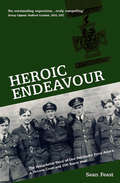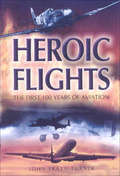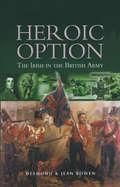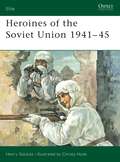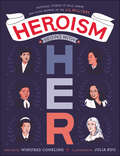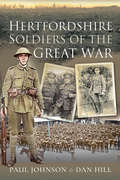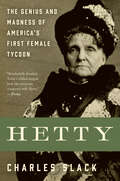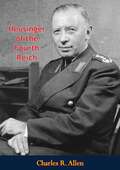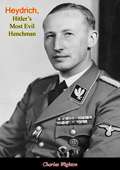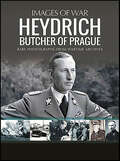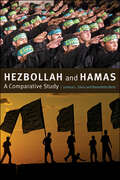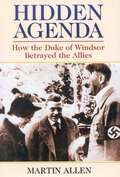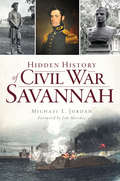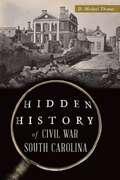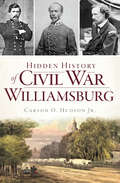- Table View
- List View
Heroes on the Home Front (Soldier Dogs #6)
by Marcus SutterTwin siblings give their dog to the Coast Guard during WWII only to discover a German threat in their hometown. The sixth book in the action-packed Soldier Dogs series that’s perfect for fans of Hero and Max!When they hear about the Dogs for Defense program, twins Charlie and Kate know their yellow lab Buster would be a perfect soldier dog. So they enlist Buster in the Coast Guard, where he works alongside Army horseback patrols to protect US shores from German U-boat attacks.Back home, Charlie and Kate discover a threat of their own—a coded message about a Nazi sabotage plan! With danger on every side, can Charlie, Kate, and Buster to defend US shores from the Axis Powers?
Heroic Endeavour: The Remarkable Story of One Pathfinder Force Attack, a Victoria Cross and 206 Brave Men
by Sean FeastThis WWII combat history offers a detailed chronicle and analysis of an RAF Pathfinder Squadron&’s ill-fated operation over Cologne. On December 23rd, 1944, an elite squadron of the Royal Air Force Bomber Command engaged in a courageous yet tragic daylight raid on the Gremberg railway yards in Cologne, Germany. One of the war&’s most significant raids, it is scarcely mentioned in history books. Yet it was an operation in which its leader won the Victoria Cross, and a future VC fought a similarly heroic battle. It was also a harrowing ordeal in which ordinary men lost their lives doing extraordinary things. In Heroic Endeavour, aviation historian Sean Feast tells the story of this fateful raid from two different perspectives. In the first part, he presents a gripping narrative recreation of the events as they unfolded. In the second, he shares retrospective interviews with survivors from both sides, as well as an analysis of what went wrong and why.
Heroic Flights: The First 100 Years of Aviation
by John Frayn TurnerA century after the Wright Brothers first took to the air, the author records those moments of aviation history that stand out from all the others for their pioneering bravery or gallantry in the face of the enemy. A fascinating potpourri embracing the whole story of aviation from those first faltering flights, through the conquest of the world by flight, the drama of war in the air, right up to the present day and the four ill-fated flights of September 11th 2001. Each story is a superb description of the great moments in the history of aviationA superb read for both the layman and aviation specialist alike
Heroic Option: The Irish in the British Army
by Desmond Bowen Jean BowenIt is a curious paradox that, while for many centuries there has been deep antagonism between the British and the Irish, the latter have fought the former's wars with exemplary courage and tenacity. This has never been better demonstrated than when, as a result of the Irish regiments' superb service in the South African War (Boer War) at the end of the 19th Century, Queen Victoria ordered the formation of the Irish Guards in 1900 as a mark of the Nation's gratitude. Even after the trauma of Partition, Irishmen continued to serve in Irish regiments in large numbers and the tradition continued today. Indeed during the Second World War a very significant number of the most influential generals were of Irish extraction.
Heroines of the Soviet Union 1941-45
by Christa Hook Henry SakaidaOsprey's examination of Soviet women who fought in World War II (1939-1945). When the Great Patriotic War began, many women volunteered for the armed forces, but most of them were rejected. They were steered towards nursing or other supportive roles. Many determined women managed to enter combat by first volunteering as field medics and nurses, then simply picking up a gun during the battle, and charging boldly into the line of fire. In the area of aviation, women also contributed greatly to the war effort. In rickety biplanes, they flew bombing missions at night, without parachutes; their only protection was the darkness. This book tells the stories of the brave women that were awarded the Soviet Union's most prestigious title - Hero of the Soviet Union - for their bravery in protecting their homeland.
Heroism Begins with Her: Inspiring Stories of Bold, Brave, and Gutsy Women in the U.S. Military
by Winifred ConklingFor fans of Rad American Women A–Z, Rebel Girls, and Women Who Dared comes an inspiring collection of more than 80 profiles about the brave women in the US military who fought hard for their country and even harder for what they believed in.From the Revolutionary War to present day, women have proudly served in the United States Army, Navy, Air Force, Marines, and Coast Guard as nurses, pilots, engineers, soldiers, and more. They dressed as men, worked for little pay and no benefits, and endured prejudice to break down barriers and earn their place beside their fellow servicemen. The achievements and courageous acts of these women forever changed the way the military operates!From well-known women to unsung heroes, this beautifully illustrated book tells incredible, captivating tales of gutsy women like Margaret Corbin, Harriet Tubman, Tammy Duckworth, and countless others.And it will prove just one thing: Women really can do anything!
Heroism and the Changing Character of War
by Sibylle ScheipersPost-heroism is often perceived as one of the main aspects of change in the character of war, a phenomenon prevalent in western societies. According to this view, demographic and cultural changes in the west have severely decreased the tolerance for casualties in war. This edited volume provides a critical examination of this idea.
Hers to Heal: A Black Eagle Ops Novel
by Vonnie DavisIn this powerful, sensual romance from the author of Her Survivor, a broken woman meets a shattered warrior—and discovers a passion strong enough to heal each other’s deepest wounds. Navy SEAL Reece Browning sacrificed body and soul in the line of duty. He survived torture at the hands of America’s enemies, but lost his career and his voice in the process. Traumatized and desperate to get his PTSD under control, Reece escapes to Eagle Ridge Ranch. Under the big Texas sky, he finds peace, a renewed sense of purpose—and a woman who makes him feel like a man again. Her smile lights up his dark days, and her caress helps him forget the night terrors. Ex-Marine Gina Wilson also bears painful scars: emotional wounds inflicted by men she once trusted with her life. She has fought hard to overcome her demons and build a good life for her daughter, and Reece is too intense, too damaged, too raw to let into her heart. Yet she’s drawn irresistibly to his steely gaze and heated embrace. No one else understands what it’s like to suffer in silence. And when Gina’s daughter is threatened, it’s Reece who risks everything to save the day.
Hertfordshire Soldiers of The Great War (Your Towns And Cities In The Great War Ser.)
by Paul Johnson Dan HillCollected first-hand accounts of British men and women serving their country during World War I, as discovered through the Herts At War community project.In Hertfordshire Soldiers of The First World War the authors explore a series of individual case studies of Hertfordshire men who served in various theaters during the First World War, all of which had been uncovered as part of the Herts At War community project. This unique collection of largely unknown accounts includes stories from the Western Front, Gallipoli, Salonika, Mesopotamia, East Africa, Egypt, and even Russia in the fight against the Bolsheviks in 1919.The Herts At War team uncovered many letters and objects in the course of their research, including men who were Victoria Cross winners to those whose courage or bravery went unrecognized, as well as stoicism on the Home Front. One of the most moving of these surrounds a photograph which was found in the hands of Sergeant Percy Buck as he lay fatally wounded in a shell hole in 1917. On the back of the photograph of his wife and young son he had written his address and asked for whoever found the image to post it to his loved ones in the event of his death. Sergeant Buck would have assumed it would be a British comrade who would find the photograph, but the person who recovered it was a German soldier who subsequently sent it on to the grieving, but grateful, family.The war memorials of Hertfordshire contain the names of over 23,000 men and women who gave their lives whilst in the service of their country during the Great War; some of their tales are uncovered here. Indeed, the poignant collection of stories, anecdotes, and artifacts revealed in this book bring the First World War to life in an unusual and highly moving fashion.
Hetty: The Genius and Madness of America's First Female Tycoon
by Charles SlackThis acclaimed biography of the Gilded Age&’s Queen of Wall Street is &“a must-read for all aspiring moguls&” (Regina Herzlinger, Harvard Business School). When J. P. Morgan called a meeting of New York's financial leaders after the stock market crash of 1907, Hetty Green was the only woman in the room. The Guinness Book of World Records memorialized her as the World's Greatest Miser, and, indeed, this unlikely robber baron—who parlayed a comfortable inheritance into a fortune that was worth about 1.6 billion in today's dollars—was frugal to a fault. But in an age when women weren't even allowed to vote, never mind concern themselves with interest rates, she lived by her own rules. In Hetty, Charles Slack reexamines her life and legacy, giving us, at long last, a splendidly &“nuanced portrait&” (Newsweek) of one of the greatest—and most eccentric—financiers in American history. This P.S. edition features an extra 16 pages of insights into the book, including author interviews, recommended reading, and more. &“[Hetty&’s] wry wit and colorful personality bring humor and pathos to this story. . . . [R]eaders cannot help from cheering for her at every turn.&” —Booklist &“An exemplary retelling for a new generation.&” —Kirkus Reviews &“Entertaining. . . . Slack . . . concentrates on telling a good story and telling it well.&” —Publishers Weekly &“Wonderfully detailed.&” —Forbes &“Page-turning.&” —Richmond Times-Dispatch &“Fascinating.&” —New York Post
Heusinger of the Fourth Reich
by Charles R. Allen“Within a year after Potsdam, this mighty Agreement was given its funeral by the then Secretary of State, Mr. James Byrnes, in his Stuttgart speech. Mr. Churchill, with President Truman at his side, adumbrated the ultimate reversal of our German policy in his Fulton speech which formally started the Cold War. A speech by Herbert Hoover to a small group of Germans whom I had assembled in Stuttgart in January 1947 was also significant: he told them that the U.S. expected their support in the coming struggle with “the atheistic barbarians of the East.”Looking back on this reversal of policy, it seems to me that the Power Elite’s major problem was to propagandize our people to accept German remilitarization in the defense of “freedom.” Heusinger of the Fourth Reich brilliantly traces step-by-step, with a scholarly documentation which cannot for a moment be challenged, how the American Power Elite has helped this criminal conspiracy, the German General Staff, to return to power with the largest, most powerful military machine in Europe today: the aggressive, Nazi-oriented and Nazi-commanded West German military establishment.Through this book, the author, Charles R. Allen, Jr., a gifted young political analyst, completely demolishes the official United States myth that the General Staff was something separate and different from Hitler’s murderous Reich; that it was a non-political, purely professional group innocently carrying out its sworn duty to serve the German people and der Führer because the General Staff’s oath was taken “under God.” What blasphemy!”-Introduction
Heydrich, Hitler’s Most Evil Henchman
by Charles WightonTHE MAN WITH THE IRON HEARTHitler called him “The man with the iron heart”—yet Reinhard Heydrich was utterly different from those other iron men who served the Führer. Gifted with intellect, charm and great courage, Heydrich used his outstanding talents to create the Nazi Security Service, the notorious SD (Sicherheitsdienst), thereby becoming one of the most powerful figures—perhaps the most evil influence of all—in Nazi Germany.Charles Wighton, through unprecedented co-operation on both sides of the Iron Curtain, has had access to top secret Nazi Party files, to official sources in East Germany, to highly secret records in Czechoslovakia—and to the frank recollections of Heydrich’s widow. The result is a fascinatingly detailed revelation of the rise of this diabolical genius.Through Heydrich’s racial campaigns, which gathered their own momentum after his death, six million Jews were murdered by 1945. And yet this son of a cultured, upper-middle-class Roman Catholic family, who became the real power behind Himmler, was himself blackmailed by the Führer for possessing non-Aryan blood.In addition to clarifying this aspect of Heydrich’s astonishing career, the author throws new light, too, on “Plan Ost”, the blueprint for the extermination of thirty million Slavs, and on the mystery surrounding Heydrich’s assassination in 1942.Here, then, is the full story of the man with the iron heart—Heydrich, Hitler’s most evil henchman.
Heydrich: Butcher of Prague (Images of War)
by Ian BaxterReinhard Heydrich along with Heinrich Himmler, whose deputy he was, will always be regarded as one of the most ruthless of the Nazi elite. Even Hitler described him as ‘a man with an iron heart’. He established his fearsome reputation in the 1930s, as head of the Sicherheitsdienst (SD), the intelligence organization which neutralized opposition to the Nazi Party by murder and deportation. He organized Kristalnacht and played a leading role in the Holocaust, chairing the 1942 Wannsee Conference which formalized plans for the ‘Final Solution’. In addition, as head of the Einsatzgruppen murder squads in Eastern Europe he was responsible for countless murders. Appointed Deputy Reich-Protector of Bohemia and Moravia, he died of wounds inflicted by British trained SOE operatives in Prague in May 1942. The reprisals that followed his assassination were extreme by even the terrible standards of Nazi ruthlessness. Heydrich’s shocking and leading role in the Nazi regime is graphically portrayed in this Images of War book.
Heydrich: The Face of Evil
by Mario R. Dederichs"A chilling study of the man who masterminded the Holocaust…Heydrich was inhumanely cruel, ruthless, devious, shameless, a sixteen hour a day workaholic who was feared and loathed even by his closest colleagues.' — The Daily Telegraph ‘An impressive mix of psychological analysis, biography and historical reporting...Dederichs descends into Heydrich's personal abyss and describes it in a captivating and intelligible manner while not rejecting the scientific approach.’ – Die Rheinische Adolph Hitler praised Heydrich as 'the man with the iron heart'. He admired Heydrich so much that, despite rumors about Jewish ancestry, he considered him a potential successor. Reinhard Heydrich was undeniably one of the Führer's most enthusiastic, brutal and ambitious henchmen and one of the key architects of the Third Reich's horrific genocide. He quickly rose through the ranks of the Nazi party and became one of the key architects of the Third Reich's horrific genocide. Indeed, after his 1942 assassination, the murder of more than 2 million people at Belzec, Sobibor and Treblina was code-named 'Action Reinhard'. In this critically-acclaimed biography, which includes interviews with some of his surviving family, Mario Dederichs creates a complete and compelling portrait of Heydrich's life. Dederichs details his short-lived naval career, to his work under the SS chief Himmler, his appointment as Stellvertretender Reichsprotektor of Bohemia and Moravia, and his assassination by Czech agents and the terrible reprisals exacted on the town of Lidice.
Hezbollah and Hamas: A Comparative Study
by Benedetta Berti Joshua L. GleisA concise yet comprehensive overview of Hamas and Hezbollah.Hezbollah and Hamas are major players in Middle Eastern politics and have a growing involvement in global events. Despite their strikingly different beginnings, they share a common denominator—an adversary in Israel. Hezbollah and Hamas draws from primary interviews and documents coupled with a thorough review of current scholarship. This is a portrait of the organizations’ roots, histories, ideologies, relationships, tactics, political outlooks, and futures. Joshua L. Gleis and Benedetta Berti present organization charts, maps, and a case study of the TriBorder Area in South America, which frequently serves as an operational center for terrorist groups. Recognizing that these two groups are increasingly relevant to U.S. national security, Gleis and Berti provide a comparative analysis of their histories and political missions that moves beyond reductionist portrayals of the organizations' military operations.
Hi Hitler!
by Gavriel D. RosenfeldThe Third Reich's legacy is in flux. For much of the post-war period, the Nazi era has been viewed moralistically as an exceptional period of history intrinsically different from all others. Since the turn of the millennium, however, this view has been challenged by a powerful wave of normalization. Gavriel D. Rosenfeld charts this important international trend by examining the shifting representation of the Nazi past in contemporary western intellectual and cultural life. Focusing on works of historical scholarship, popular novels, counterfactual histories, feature films, and Internet websites, he identifies notable changes in the depiction of the Second World War, the Holocaust, and the figure of Adolf Hitler himself. By exploring the origins of these works and assessing the controversies they have sparked in the United States and Europe, Hi Hitler! offers a fascinating and timely analysis of the shifting status of the Nazi past in western memory.
Hidden Agenda: How the Duke of Windsor Betrayed the Allies
by Martin AllenHow did the Duke of Windsor betray the allies and did his war time activity amount to treason? This book,the result of the author's research will seek to answer these questions.
Hidden Atrocities: Japanese Germ Warfare and American Obstruction of Justice at the Tokyo Trial (A Nancy Bernkopf Tucker and Warren I. Cohen Book on American–East Asian Relations)
by Jeanne GuilleminIn the aftermath of World War II, the Allied intent to bring Axis crimes to light led to both the Nuremberg trials and their counterpart in Tokyo, the International Military Tribunal of the Far East. Yet the Tokyo Trial failed to prosecute imperial Japanese leaders for the worst of war crimes: inhumane medical experimentation, including vivisection and open-air pathogen and chemical tests, which rivaled Nazi atrocities, as well as mass attacks using plague, anthrax, and cholera that killed thousands of Chinese civilians. In Hidden Atrocities, Jeanne Guillemin goes behind the scenes at the trial to reveal the American obstruction that denied justice to Japan’s victims.Responsibility for Japan’s secret germ-warfare program, organized as Unit 731 in Harbin, China, extended to top government leaders and many respected scientists, all of whom escaped indictment. Instead, motivated by early Cold War tensions, U.S. military intelligence in Tokyo insinuated itself into the Tokyo Trial by blocking prosecution access to key witnesses and then classifying incriminating documents. Washington decision makers, supported by the American occupation leader, General Douglas MacArthur, sought to acquire Japan’s biological-warfare expertise to gain an advantage over the Soviet Union, suspected of developing both biological and nuclear weapons. Ultimately, U.S. national-security goals left the victims of Unit 731 without vindication. Decades later, evidence of the Unit 731 atrocities still troubles relations between China and Japan. Guillemin’s vivid account of the cover-up at the Tokyo Trial shows how without guarantees of transparency, power politics can jeopardize international justice, with persistent consequences.
Hidden Away (A KGI Novel #3)
by Maya BanksA man who shoots first and asks questions later falls for the ultimate moving target in this sexy, action-packed KGI novel. The Kelly Group International (KGI): A super-elite, top secret, family-run business. Qualifications: High intelligence, rock-hard body, military background. Mission: Hostage/kidnap victim recovery. Intelligence gathering. Handling jobs the U.S. government can&’t... Most people would take an all-expenses-paid trip to the beach in a heartbeat, but Garrett Kelly only accepts the job keeping tabs on Sarah Daniels—who&’s in hiding after witnessing a murder committed by her half-brother—for the chance to take down a person enemy of KGI. A disciplined soldier like Garrett is trained for so much more than a babysitting gig, but he soon realizes that there&’s more to Sarah than what&’s in her file. Garrett is considering seduction as a tactical maneuver, but when he glimpses Sarah&’s dark past, he feels an urgent desire to keep her safe—even after she disappears on him. Garrett doesn&’t know exactly who, or what, Sarah&’s running from. Whatever it is, she&’s running for her life...
Hidden Children Of The Holocaust: Belgian Nuns And Their Daring Rescue Of Young Jews From The Nazis
by Suzanne VromenIn the terrifying summer of 1942 in Belgium, when the Nazis began the brutal roundup of Jewish families, parents searched desperately for safe haven for their children. As Suzanne Vromen reveals in Hidden Children of the Holocaust , these children found sanctuary with other families and schools-but especially in Roman Catholic convents and orphanages. Vromen has interviewed not only those who were hidden as children, but also the Christian women who rescued them, and the nuns who gave the children shelter, all of whose voices are heard in this powerfully moving book. Indeed, here are numerous first-hand memoirs of life in a wartime convent-the secrecy, the humor, the admiration, the anger, the deprivation, the cruelty, and the kindness-all with the backdrop of the terror of the Nazi occupation. We read the stories of the women of the Resistance who risked their lives in placing Jewish children in the care of the Church, and of the Mothers Superior and nuns who sheltered these children and hid their identity from the authorities. Perhaps most riveting are the stories told by the children themselves-abruptly separated from distraught parents and given new names, the children were brought to the convents with a sense of urgency, sometimes under the cover of darkness. They were plunged into a new life, different from anything they had ever known, and expected to adapt seamlessly. Vromen shows that some adapted so well that they converted to Catholicism, at times to fit in amid the daily prayers and rituals, but often because the Church appealed to them. Vromen also examines their lives after the war, how they faced the devastating loss of parents to the Holocaust, struggled to regain their identities and sought to memorialize those who saved them.
Hidden Children: The Secret Survivors of the Holocaust
by Jane MarksThey hid wherever they could for as long as it took the Allies to win the war -- Jewish children, frightened, alone, often separated from their families. For months, even years, they faced the constant danger of discovery, fabricating new identities at a young age, sacrificing their childhoods to save their lives. These secret survivors have suppressed these painful memories for decades. Now, in The Hidden Children, twenty-three adult survivors share their moving wartime experiences -- some for the first time.There is Rosa, who hid in an impoverished one-room farmhouse with three others, sleeping on a clay pallet behind a stove; Renee, who posed as a Catholic and was kept in a convent by nuns who knew her secret; and Richard, who lived in a closet with his family for thirteen months. Their personal stories of belief and determination give a voice, at last, to the forgotten. Inspiring and life-affirming, The Hidden Children is an unparalleled document of witness, discovery, and the miracle of human courage.
Hidden Heroes: America's Military Caregivers
by Terri Tanielian Rajeev Ramchand Michael P. Fisher Christine Anne Vaughan Thomas E. Trail Caroline Epley Phoenix Voorhies Michael William Robbins Eric Robinson Bonnie Ghosh-DastidarLittle has been reported about "military caregivers"--the population of those who care for wounded, ill, and injured military personnel and veterans. This report summarizes the results of a study designed to describe the magnitude of military caregiving in the United States today, as well as to identify gaps in the array of programs, policies, and initiatives designed to support military caregivers.
Hidden History of Civil War Savannah (Civil War Series)
by Foreword By Morekis Michael L. JordanUnion general William T. Sherman cemented Savannah’s most notable Civil War connection when he ended his “March to the Sea” there in December 1864. However, more fascinating stories from the era lurk behind the city’s ancient, moss-draped live oaks. A full-scale naval battle raged between ironclad warships just offshore. More than seven thousand prisoners were confined in the area surrounding Forsyth Park. And on March 21, 1861, the present-day Savannah Theatre was the site of one of the most inflammatory and controversial speeches of the entire war. Noted local filmmaker and author Michael Jordan delves deep into this fabled city’s Civil War past.
Hidden History of Civil War South Carolina (Hidden History)
by D. Michael ThomasUntold Stories of the War Between the StatesAll of South Carolina’s history during the Civil War isn’t well known. Author D. Michael Thomas has uncovered fifty accounts of lost history pertaining to the state and its men during the war. These are stories of astounding chivalry and valor in the face of horrific tragedies, along with unprecedented events. A single South Carolinian captured nearly six hundred Union soldiers. Lieutenant Alexander Chisolm had an extraordinary career. See the connection between South Carolina College and its Confederate generals. Learn little-known tales about naval operations from the Union and the Confederacy and witness the recovery of the state’s “Gettysburg Dead.” Join the author as he recounts these hidden stories and more.
Hidden History of Civil War Williamsburg (Civil War Series)
by Carson O. Hudson Jr.Each year, thousands of visitors from around the country visit the Colonial Williamsburg Foundation's re-created eighteenth-century capital of Virginia to learn about the past and walk where the Founding Fathers walked. The fact that the same ground was later soaked with the tears and blood of their children and grandchildren during our tragic Civil War is frequently forgotten. In this expanded and revised version of Yankees in the Streets: Forgotten People and Stories of Civil War Williamsburg, local historian Carson Hudson tells the stories of this hallowed ground and the people who walked it.

